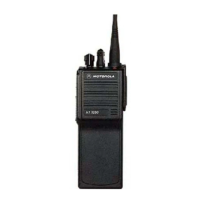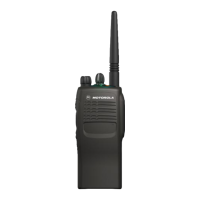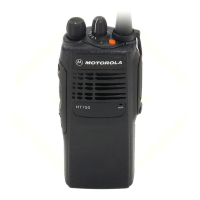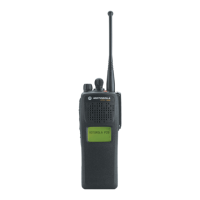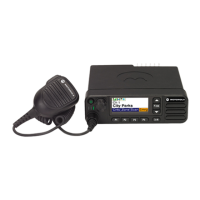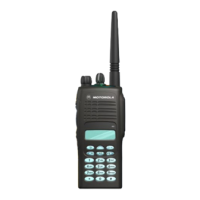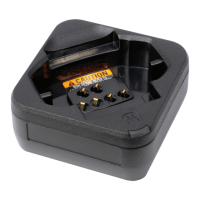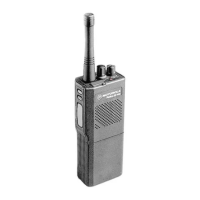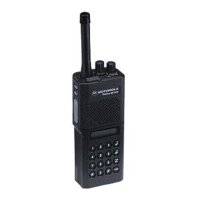24
b. Rigid Circuit Boards
This family of radios uses bonded, multi-layer,
printed circuit boards. Since the inner layers are
not accessible, some special considerations are
required when soldering and unsoldering com-
ponents. The printed-through holes may
interconnect multiple layers of the printed cir-
cuit. Therefore, care should be exercised to
avoid pulling the plated circuit out of the hole.
When soldering near the module socket pins,
use care to avoid accidentally getting solder in
the socket. Also, be careful not to form solder
bridges between the module socket pins.
Closely examine your work for shorts due to
solder bridges. When removing modules with
metal enclosures, be sure to desolder the
enclosure ground tabs as well as the module
pins.
c. Flexible Circuits
The flexible circuits are made from a different
material than the rigid boards, and different
techniques must be used when soldering.
Excessive prolonged heat on the flexible circuit
can damage the material. Avoid excessive heat
and excessive bending. For parts replacement,
use the ST-1087 Temperature-Controlled Sol-
der Station with a 600 or 700 degree tip, and
use small diameter solder such as ST-633. The
smaller size solder will melt faster and require
less heat being applied to the circuit.
To replace a component on a flexible circuit,
grasp the edge of the flexible circuit with seizers
(hemostats) near the part to be removed, and
pull gently. Apply the tip of the soldering iron to
the component connections while pulling with
the seizers. Do not attempt to puddle out com-
ponents. Prolonged application of heat may
damage the flexible circuit.
2. Specific
During all repair procedures, heating neighboring
components can be minimized by:
• using upper heat only.
• using the correct size heat-focus head, approxi-
mately the same size as the carrier being
replaced.
• keeping the heat focus head approximately 1/8”
above the printed circuit board when removing
or replacing the device.
a. Strip Connector (P301/P704)
On the latest version HT 1000, MT 2000,
MTS 2000, and MTX series radios, a strip con-
nector, two female connectors and a strain relief
electrically connect the RF board with the con-
troller board. On earlier versions of these
radios, the RF board and controller board were
connected using a jumper flex that soldered
directly to the circuit board solder pads.
An interconnect kit, REX4035A, is available to
retrofit earlier version jumper-flex radios with
the later version strip connector parts. The
REX4035A kit includes the following items:
• CONNECTOR, Female (J301) 0905461X01
• CONNECTOR, Female (J704) 0905461X01
• CONNECTOR, Male
(P301/P704) 0905461X01
• STRAIN RELIEF 4205507X01
• INSTRUCTIONS 6880309F14
b. Jumper Flex (on radios shipped prior to 7/94)
Jumper flexes are not available.They are
replaced with connectors as described in para-
graph “a” of this section. If the jumper flex
needs to be replaced, order Interconnect Kit
REX4035A. The retrofit kit includes all of the
parts required and detailed instructions on the
removal of the old jumper flex, and the installa-
tion of the new connector arrangement.
c. RF Switch (S101):
Refer to the applicable exploded view and to
your radio's RF board (antenna contact area) to
locate the RF switch components.
NOTE
The RF switch spring and the RF switch piston
must be ordered separately.
To remove the RF switch:
(1) On VHF and UHF radios, unsolder the two
tabs of the RF switch bracket that secure
the RF switch to the RF board. On 800MHz
and 900MHz radios, use a #2 slotted
screwdriver to straighten the two tabs of the
RF switch bracket that wrap around the RF
board. Use your forefinger to hold the RF
switch bracket to the RF board while
straightening the tabs to avoid lifting the
solder tabs on the opposite end of the RF
switch bracket.
If neighboring OMPAC components are heat-
ed above 365 degrees F. (185 degrees C.),
they will suffer die-bond delamination and
possible “popcorn” failure.
!
CAUTION
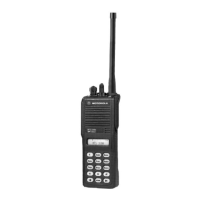
